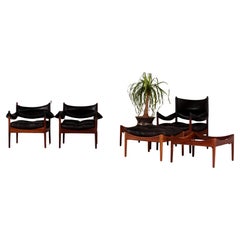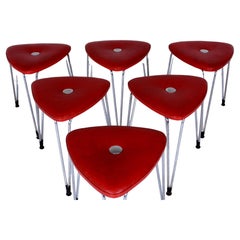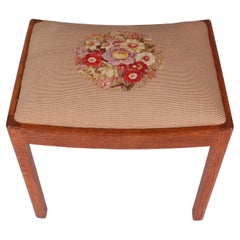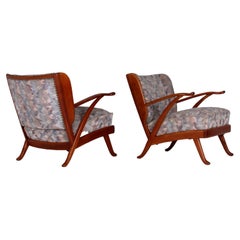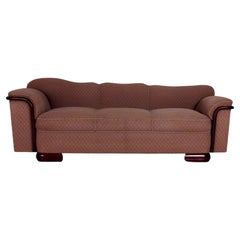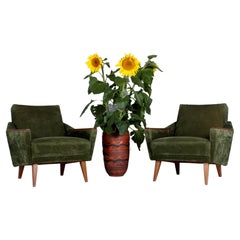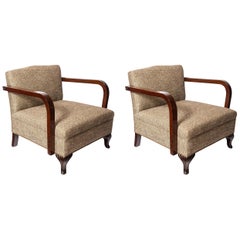STiLODROM Seating
to
1
6
6
Height
to
Width
to
Depth
to
2
1
1
2
3
1
1
1
6
1
5
1
1
2
1
5
5
3
2
2
6
4
1
1
1
6
6
6
1
1
MODUS by Kristian Solmer Vedel SET of 3 lounge chairs 1 stool & 2 coffee tables
By Kristian Solmer Vedel
Located in Landshut, BY
This set was designed by Kristian Solmer Vedel for the renowned Søren Willadsen Møbelfabrik in Denmark.
It boasts excellent original condition.
The set includes two lounge armchair...
Category
Vintage 1960s Danish Scandinavian Modern Stools
Materials
Aluminum
SET of SIX mid-century STOOLS by Günter Talos Vienna chrome iron pin legs 1950s
By Günter Talos
Located in Landshut, BY
SOLID HEAVY DUTY MADE FOR THE ETERNITY
Six mid-century stools designed and made in Vienna around 1950 by J. A. Talos, Vienna XII. Bezirk , Dörfelstraße 6-8 .
The architectually sig...
Category
Vintage 1950s Austrian Mid-Century Modern Stools
Materials
Chrome, Iron
art nouveau oak stool chair Jugendstil Rabenau embroidery a. 1910 exc condition
Located in Landshut, BY
solid built oak
Jugendstil
CHAIR
made in Rabenau / Saxonia
upholstered with care - fitted with hand embroidered jute fabric
Rabenau's chairmaking tradition is almost 400 years ol...
Category
Vintage 1910s German Art Nouveau Chairs
Materials
Wool, Jute, Oak
Midcentury set of 2 solid cherry wood wingback armchairs & sofa Karl Nothhelfer
Located in Landshut, BY
just beautiful
SET of Sofa & 2 Wingback Armchairs
by Prof. Karl Nothelfer - Designed in 1957
maker: Schörle & Gölz in Stuttgart - Bad Cannstatt
solid Cherry Wood
new upholstery and fabrics in 1998 according to last owner ( since then just in use for 2 years so upholstery is perfect ! )
Seatrests can be removed - and fixed by clips on belts
- high class -
measurements:
easy chair is 70cm wide ~ sofa is 178cm wide
both: seating height 40cm ~ seating depth: 57cm
condition - all firm and in very good condition - no damages
furniture have fully been accurately cleaned ::
- 3 steps: A: air pistol - B: industrial hoover - C: latest Kärcher "wash&hoover" technology
- woods have been polished several times
note: please ask for shipping quote by sending us your postcode/destination
Prof. Karl Nothelfer
* 14 June 1900 ~~ + 20 May 1980
Since the beginning of the 15th century, the Nothelfer family of carpenters has been continuously resident in the former
town of Überlingen without interruption. Every carpenter at that time mastered
all the possibilities of woodworking: so did the Nothelfer. They could carpenter,
even carve altars and figures, and set them in gold, silver and paint.
(churches in Owingen and Hödingen]. Some family members lived and worked
and worked in Hedingen or Hödingen,like today the jubilarian Karl Nothelfer (this in 1975).
His father, Karl Anton Nothelfer, as the eldest of seven siblings, was able to take over his father's carpentry business in Überlingen.
Karl Anton Nothelfer, the eldest of seven siblings, was unable to take over his father's carpentry business in Überlingen.
He instead moved to the industrial town of Singen with his young wife Rosalie, née Hanner, from the
from Hohenzollern in 1896 and moved to the former Poststraße and founded his own carpenter's workshop.
He had a highsense of quality and form and was already a member of the German Werkbund before 1914.
Karl Nothelfer and his three siblings grew up in such air.
After attending school and the secondary school in Singen, the young Karl learned the carpenter's trade in his father's workshop then moved on to the Badische Landes-Kunstschule in Karlsruhe,
where he studied architecture. At that time the well-known furniture professor also worked there
Fritz Spannagel, born in Freiburg in 1891, who settled in 1938 at Ittendorf Castle near Meers-
burg (died 1957). In 1928, the gifted young architect received a teaching assignment at the
at the Karlsruhe School of Art, but followed his teacher Spannagel to Berlin in the same year.
Berlin. Here he worked from 1928-1945 as a teacher - appointed professor in 1931 - at the
Berlin Tischler-Schule, the later Bauschule für Raumgestaltung.
The furniture he created in Berlin became internationally known through many exhibitions and lectures.
nationally known and influential. His furniture creations ushered in a new era in German and
a new era in German and European furniture design. At the world exhibition in Paris
1937 Prof. Nothelfer was awarded the Golden Medal for his work in the furniture sector.
for his work in the furniture sector. A first summary and balance of his work on furniture is given in his standard work
1942 published standard work "Das Sitzmöbel", the first compendium of its kind in the world.
world. In 1950 he published his second work "Furniture". Both books and a
series of brochures were published by Verlag Otto Maier, Ravensburg.
Karl Nothelfer continued to work intensively on the design of seating furniture in the years after 1945.
In 1950 he succeeded in the important invention of the two-legged skid-base chair, which has been
orthopedically - anatomically tested thousands of times - has become accepted all over the world today.
Even the most distinguished American furniture companies such as Miller or Knoll-International
use the skid as the main theme for desks and chairs. At the same time, N. had a groundbreaking
in the redesign of German school furniture and seating for industry.
industry. He succeeded in adapting his furniture forms, which originated in wood and handicraft, to the modern technical
modern technical possibilities of the industry. He thus became the great refor-
of schoolroom furnishings. The architect Nothelfer thinks about himself,
that he made his main contribution in the field of seating furniture, although this was not
was not really his profession.
After the war, Prof. Nothelfer, like so many others, had to start all over again. He settled
settled in his home town of Lake Constance in Hödingen in 1945 as a freelance architect and was
and was involved in all areas of construction in the years after the war. As early as 1935, he had given many
the example of American prefabricated buildings and recommended serial house
and recommended it at a time when no one in Germany was even thinking about mass production. Now he developed
he developed several types of mass-produced houses, which were manufactured in Baiersbronn.
of which more than 800 houses were built in France alone (types Paris, Provence, Normandie).
were built. At that time [1946], as part of the reparations in Strasbourg, there was an exhibition of houses with Swedish, Danish, and French designs.
with Swedish, Danish, Finnish, English and German houses, where the French occupation
for which 6 different types were sent from the French occupation zone, the
Nothelfer's house type was considered the top of this exhibition.
Karl Nothelfer was also involved in the development of chipboard. In 1946, together with others in Munich, he founded the first
magazine "Bauen und Wohnen" ("Building and Living") after the war and remained its co-editor for many years.
co-editor of this magazine for many years. By presenting his own work, he has here
interpreted what the essence of the magazine wanted to be: Building, in order to live in it, in order to live as a human being and humanly in the built. Karl Nothelfer planned his houses
furniture ground plan, from the need for living. In 1948 he was appointed honorary senator of the State Building
school in Holzminden.
Karl Nothelfer did not build much in Singen. The first post-war house was Haus
Fahr on the slope of the Hohentwiel (Domäne); the building material came from a demolished
log house that a French officer had built for himself on the Schie- nerberg.
nerberg. In 1952, he also built the administration building of the aluminum rolling mill in Singen.
rolling mills in Singen, with relief and wall painting by C. G. Becker. In Überlingen he built
In Überlingen he built, among others, the Buchinger Sanatorium, the Riese+ Hähnel radio house and
various reconstructions in the old town: Haus Kitt with the Glockenspiel, the Haus mit dem
Bacchus in the Überlingen village, the Dolphin Fountain in Hödingen (1975). Probably the most beautiful
Haus Nothelfers, the Haus Himmelheber, stands in Baiersbronn-Tonbach. On the airfield
Mengen, Nothhelfer built the casino building with the 30 square meter faience painting Ikarus by
C. G. Becker. In 1954 he founded a second office with architect Hans Schwingen in Düsseldorf.
Office, which primarily fertilized the housing construction, true to the motto:from the inside to
planning from the outside. The Minister of Housing awarded a prize to the best social housing in North Rhine-
Westphalia; it was from the Nothelfer+Schwingen studio in Düsseldorf. Also the idea of
new idea of home ownership was also promoted by Nothelfer+Schwingen.
promoted by Nothelfer+Schwingen. On the occasion of the red jubilee of the law about condominium ownership
Nothelfer gave a lecture in Essen in 1961 on condominium ownership in Europe (published as a brochure).
published as a brochure]. From Düsseldorf, among many others, in the silk city...
Category
Vintage 1950s German Mid-Century Modern Living Room Sets
Materials
Fabric, Cherry, Upholstery
STRAIGHT classic art deco SOFA Dresden around 1930 or. fabric - wood refinished
Located in Landshut, BY
""~!~** STRAIGHT **~!~**
This classic art deco sofa was produced in the Dresden area in the 1930s
Its shape is quite unique and very well proportioned
Its spring upholstery is still strong and fully undamaged
All wooden parts have been demounted sanded and stained - then treated (sprayed) with a transparent Acrylic Silk Matt Paint
finish and professionally remounted.
The sofa has fully been accurately cleaned ::
:: 3 steps: A: air pistol...
Category
Vintage 1930s German Art Deco Sofas
Materials
Wood, Fabric, Beech
$3,583 Sale Price
33% Off
pair of 1960s lounge chairs green velvet - beech WG solid make uph. easy chairs
Located in Landshut, BY
This set of two West German lounge chairs is in very good condition
It was made in the mid 1960s
The armrests have been professionally restored (sanded - stained and lacquered tw...
Category
Mid-20th Century German Mid-Century Modern Lounge Chairs
Materials
Wood, Velvet, Beech
Related Items
1930s Art Deco sofa , Czechoslovakia
Located in Praha, CZ
Seat Height 47cm
Category
Vintage 1930s Czech Art Deco Sofas
Materials
Fabric, Wood
Pair of Wood and Fabric Armchairs, Art Deco Period, France, circa 1940
Located in Buenos Aires, Buenos Aires
Pair of wood and fabric armchairs. Art Deco Period. France, circa 1940.
Category
Vintage 1940s French Art Deco Armchairs
Materials
Fabric, Wood
$7,000 / set
H 27.56 in W 29.53 in D 27.56 in
Danish Wingback Cashmere Armchair
Located in Long Island City, NY
Danish wingback armchair c. 1950's newly reupholstered in cream cashmere with contrast piping and an ash wood frame.
Category
Vintage 1950s Danish Wingback Chairs
Materials
Wool, Ash
Set of Two Art Nouveau Oak Chairs
Located in Darmstadt, DE
Two chairs from the Art Nouveau period, ca. 1900. the chairs are made of solid oak wood and newly upholstered and covered with new fabric. restored in very good condition and just a ...
Category
Antique Early 1900s German Art Nouveau Chairs
Materials
Oak
Kristian Vedel Willadsen Møbelfabrik Modus MCM Rosewood Leather Lounge Chairs
By Soren Willadsen Mobelfabrik, Kristian Vedel
Located in Countryside, IL
Kristian Vedel for Willadsen Møbelfabrik Modus Mid Century Danish Rosewood and Leather Lounge Chairs - Pair
Each lounge chair measures: 28 wide x 26 deep x 26 high, with a seat heig...
Category
Vintage 1970s Danish Mid-Century Modern Lounge Chairs
Materials
Leather, Rosewood
$6,495 / set
H 26 in W 28 in D 26 in
Set of Four Mid Century Bamboo Swivel Stools Ashcraft Heywood Wakefield c 1950s
By Heywood-Wakefield Co.
Located in New York, NY
Exceptional set of four swivel bar stools by Heywood Wakefield as part of the classic Ashcraft series, circa 1940's . The bases are constructed of solid ash, the tops are in original...
Category
Mid-20th Century American Mid-Century Modern Stools
Materials
Upholstery, Bamboo
$1,600 / set
H 29.5 in Dm 15 in
Dutch Art Deco Design Sofa by Pander 1930 Walnut Burl Wood with Display Cabinets
By H.Pander & Zonen
Located in Ijzendijke, NL
Marvelous high end design Dutch Art Deco sofa designed & produced by Pander 1930 in Burl Walnut.
Exquisite Art Deco design lines & both sides of ...
Category
Vintage 1930s Dutch Art Deco Sofas
Materials
Walnut, Burl
$8,244
H 32.68 in W 83.47 in D 32.29 in
Jugendstil, Art Nouveau, Liberty Chair, 1900, France
Located in Ciudad Autónoma Buenos Aires, C
Chair Jugendstil, Art Nouveau, Liberty
Material: Wood
Country:France
We have specialized in the sale of Art Deco and Art Nouveau and Vintage styles since 1982.If you have any questi...
Category
Antique Early 1900s French Art Nouveau Chairs
Materials
Wood
Josef Hoffmann attr. Pair of Extraordinary Chairs 1905-10 Jugendstil Art Nouveau
By Josef Hoffmann, Woka Lamps
Located in Vienna, AT
A pair of extraordinary chairs in the style of the early Josef Hoffmann furniture. The significant skids were used by Hoffmann in the early years of the Wiener Werkstätte from 1903 o...
Category
Antique Early 1900s Austrian Jugendstil Chairs
Materials
Fabric, Wood
$17,443 / set
H 40.56 in W 18.12 in D 18.12 in
Kristian Vedel Modus Rosewood Ottoman
By Kristian Solmer Vedel
Located in Brooklyn, NY
Pretty Kristian Vedel Modus rosewood ottoman from the 1960s. Black tufted leather cushion is in good condition with age-appropriate wear. The rosewood f...
Category
20th Century Danish Mid-Century Modern Ottomans and Poufs
Materials
Leather, Rosewood
Danish Art Deco or Early Midcentury Sofa with Open Wooden Armrests, 1930's
By Fritz Hansen
Located in Bridgeport, CT
Superb Danish late Art Deco early midcentury sofa from the late 1930's or early 1940s with spring cushions and beautiful open armrests and legs carved in solid Cuban mahogany with gr...
Category
Vintage 1940s Danish Art Deco Sofas
Materials
Wool, Mahogany
$4,800
H 32.5 in W 68.5 in D 29 in
Thonet Black Swivel Austrian Art Nouveau Chair, 1890
By Thonet
Located in Rome, IT
Thonet swivel chair for piano from the end of the 1800s.
The chair in bent wood, is all in wood polished in black shellac. The seat, round in shape, is still covered with its origin...
Category
Antique 1890s Austrian Art Nouveau Chairs
Materials
Wood
